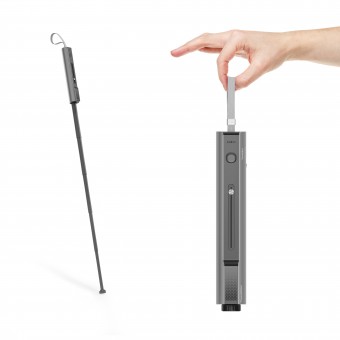DESIGN NAME:
Touchnav
PRIMARY FUNCTION:
Navigation Cane
INSPIRATION:
Inspired by the intrinsic human need for security and familiarity, we recognise that this need is particularly evident in the travel of the visually impaired. Traditional aids are often more focused on obstacle detection and fall short in providing spatial and distance perception. Can we use haptic feedback, a technology that converts complex data such as distance and direction into simple tactile signals, to provide a new navigation experience for visually impaired users?
UNIQUE PROPERTIES / PROJECT DESCRIPTION:
Traditional visual impairment aids focus on obstacle detection but lack in providing spatial and distance awareness. Touchnav converts invisible navigation paths into physical tactile feedback, enabling users to intuitively sense remaining distances, thus addressing this gap. Additionally, its vibration feature for identifying familiar locations boosts navigational confidence, significantly reducing anxiety in unfamiliar areas.
OPERATION / FLOW / INTERACTION:
The primary function of this product is to materialize the entire navigation process into tangible form, which is achieved through four key steps: 1. Users can interact with Touchnav by pressing a voice command button to input their desired destination. 2. Upon receiving the voice input, Touchnav retrieves detailed information about the specified destination, including the location's coordinates, the user's estimated distance, and the anticipated travel time, providing a comprehensive overview for the user. 3. As the user moves, a progress bar slider on the cane advances in accordance with the planned navigation route, offering a tactile representation of the user's journey and the remaining distance to the destination. 4. In addition to tactile feedback, Touchnav also includes an audio module that verbally announces important location information along the route. This dual-mode feedback ensures that users receive clear and understandable navigation cues, enhancing their spatial awareness and orientation abilities.
PROJECT DURATION AND LOCATION:
The project started in Hangzhou, China, in April 2023 and was completed in Macau, China, in January 2024.
FITS BEST INTO CATEGORY:
Social Design
|
PRODUCTION / REALIZATION TECHNOLOGY:
The grip of the Touchnav is fabricated from ABS plastic material through the injection moulding process, with its surface treated with metal sandblasting to enhance its texture. It employs a snap-fit connection structure, making it easy to assemble and disassemble. To improve its waterproofness, a gasket is installed inside the grip, thus extending the product's lifespan. The main shaft of the walking stick is made from lightweight aluminium alloy, not only ensuring the product's waterproof and heat-resistant properties but also catering to the need for portability during travel. The smooth design of the shaft assures the extendibility of the walking stick. As for the tip of the cane, it is encased in wear-resistant PE hard plastic and 316 stainless steel, enhancing its durability while also ensuring excellent waterproof and anti-corrosion capabilities.
SPECIFICATIONS / TECHNICAL PROPERTIES:
Contracted Length 170mm Width 30mm Height 33mm Extended Length 1200mm
TAGS:
White cane, navigation, mobility assistive technology, progress bar, tactile feedback
RESEARCH ABSTRACT:
There are approximately 43 million visually impaired individuals worldwide, and the lack of independent and safe mobility is identified as the greatest barrier to their travel. Navigating can be particularly challenging for visually impaired persons, especially when confronted with complex traffic information, leading to anxiety due to a lack of safety. To underscore the significance of assistive mobility technologies in this context, we conducted qualitative research on the travel issues faced by visually impaired individuals. Our study involved user interviews for in-depth needs analysis, employing the Kano model to evaluate the use of mobility tools. We ultimately determined that converting navigation maps into tangible tactile feedback aids visually impaired individuals in enhancing their spatial and distance perception, thereby boosting their independence and sense of security while travelling. Our solution, Touchnav, is a navigational white cane that allows users to intuitively perceive distance and direction, reducing their anxiety in unfamiliar environments. Feedback from participants suggests that tactile feedback is regarded as a unique spatial perception ability, enhancing their safety and independence during mobility.
CHALLENGE:
The biggest challenge in this design activity is to transform abstract navigation information into tangible tactile feedback that can be intuitively perceived by visually impaired individuals. During the project development and implementation process, it is crucial to ensure that the technological solutions are innovative yet practical and meet the specific needs of visually impaired users. Internal challenges include understanding the perception methods of visually impaired users, designing intuitive tactile feedback mechanisms, and ensuring the comfort and ease of use of the device. External factors involve compliance with relevant laws and standards, the feasibility of the technology, production costs, and market acceptance. Overcoming these challenges requires interdisciplinary collaboration, involving experts from engineering, design, anthropology, psychology, and other fields, working together to ensure that the design meets the needs of visually impaired individuals and is viable and sustainable for practical application.
ADDED DATE:
2024-02-25 22:05:16
TEAM MEMBERS (5) :
Designer: Jifeng Shen, Designer: Tianhao Liu, Designer: zinan Li, Designer: Yaowei Zheng and Designer: Pengyu Chen
IMAGE CREDITS:
Jifeng Shen, Tianhao Liu and Guanghui Huang, 2023.
|









